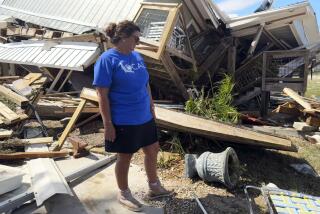Irene’s flood leaves an old mill city foundering
Reporting from Paterson, N.J. — At the corner of River and Montgomery streets, an egret stood in a shallow lake that shouldn’t have been there. An abandoned Range Rover sat nearby, caked in mud from days underwater. The “swish, swish” of brooms sweeping pools of sludge from ruined storefronts drifted down the block.
By the time President Obama visits this old mill city on Sunday, Irene will be long gone. The tropical storm roared through New Jersey a week ago, and attention quickly turned northward to the damage it wrought in green, hilly New England. But its effects are still being felt here, from the scores of people who remained in shelters Saturday to the worries of locals who have a turbulent bond to the river that runs through their struggling city.
Paterson isn’t the only place along the Passaic River to flood as a result of Irene, but it may be the least financially equipped to deal with it. Once a booming factory town, Paterson today is known as much for its problems as for the Great Falls tumbling through the city, which supplied the hydroelectric power that fueled its now-dormant mills.
Photos: Irene wrecks Paterson, N.J.
About 30% of the population lives below the poverty level, according to U.S. census figures, a far cry from the days when its manufacturing prowess earned it the moniker “the cradle of American industry.”
“This is just one issue of many,” said Bernard Moore, a Paterson native, standing on a footbridge overlooking the 77-foot Great Falls on Saturday as they roared over a rocky ridge of the Passaic. In the pools below and on the banks behind businesses and homes in Paterson, the detritus of floods piled up: tires; tree trunks; sodden bundles of clothing; plastic bags filled with trash; glass bottles and plastic jugs.
Moore, a computer programmer who works about 20 miles away in New York City, said as far as he was concerned, Irene was over. “Now we should focus on cutting crime and getting jobs here,” he said, noting that floods — albeit not as bad as this year’s — occur regularly in Paterson, which sits near the bottom of the Passaic River basin.
But fixing Paterson’s other problems circles back to the 80-mile-long river, a lifeline to this area but one with floods that have become costlier over the years.
A commission appointed by Republican Gov. Chris Christie last year blamed much of the problem on development in the flood plain.
The commission, composed of seven environmentalists, politicians and engineers, said the flood plain lost about 4.5% of its wetlands and 7.5% of forested areas from 1985 to 2007, mainly to development that is regularly swamped. Its 15 recommendations included federal buyouts of property in the flood plain, elevating property on stilts, and a moratorium on flood-plain development.
The Mississippi River, for example, is hemmed in by miles of levees that prevent major population areas from flooding when the river is swollen — but no such system exists along the Passaic. Paterson’s location at the bottom of the basin puts it in an especially precarious position.
“Paterson is the last municipality to get hit, and when we get hit, we get hit bad,” said Donna Nelson-Ivy, director of the city’s Department of Health and Human Services, as she worked with Red Cross volunteers to arrange transport for displaced locals who needed to be moved to a shelter for showers and food. In the parking lot of the high school serving as the shelter, Mayor Jeffery Jones stood in a giant circle of volunteers and evacuees and offered encouragement, but also a warning.
“The river has told us, we need to rise above the level we were at,” he said, speaking both figuratively and literally.
In an interview, Jones said the river commission’s ideas were fine, but he expressed frustration with decades of high-level talks that have focused on the Passaic’s threats with little resulting action. And trying to backpedal on development when the region sorely needs jobs isn’t the answer, said Jones, as his cellphone buzzed impatiently.
“It’s the White House,” he said, handing the phone to his chief of staff, before returning to the topic of how best to tame the Passaic. “We built the city near a river because it was prudent, sound development, but you can’t let your guard down. It’s a mean, fierce power. It’s reminding us, ‘Listen, I’m still here.’”
By Saturday afternoon, 90 people remained at the school shelter, but more evacuees were at another shelter down the street, and hundreds of people were still believed to be staying with friends or relatives out of the flood zones.
Evacuee Kent Harrison returned to his house on Presidential Boulevard to air it out and to try to pound out the dents left in his sister’s car when a tree fell on it during the storm.
Water had filled the basement and first floor of the wood house, which Harrison’s grandfather had bought decades earlier. “It ain’t doing too good now,” said Harrison, one of few people on the eerily quiet street, where the buildings showed waterlines midway up their front doors.
Near River and Montgomery, the situation was worse. Wide-screen TVs brought into a shop for repairs sat on the sidewalk, ruined by waters that rose to the overhead shelves where employees had placed things for safekeeping. The force of the water had smashed some store windows, and it had destroyed about $80,000 worth of equipment at Julio Gomez’s auto repair shop down the block.
“I’m broke now,” said Gomez, who was sloshing mud onto the street in a seemingly fruitless effort to clean up.
Luis Colon, whose karate school nearby was also swamped, speculated that the river could be better managed, perhaps by diverting water upstream before it barrels into Paterson. But he conceded that this would mean flooding other populated areas.
“How much can this building take?” he wondered aloud, looking at the worn brick structure where his Asian Karate Institute has been located for 17 years. After this, the latest of several floods, Colon conceded that there might only be one answer: “Move out.”
More to Read
Sign up for Essential California
The most important California stories and recommendations in your inbox every morning.
You may occasionally receive promotional content from the Los Angeles Times.










